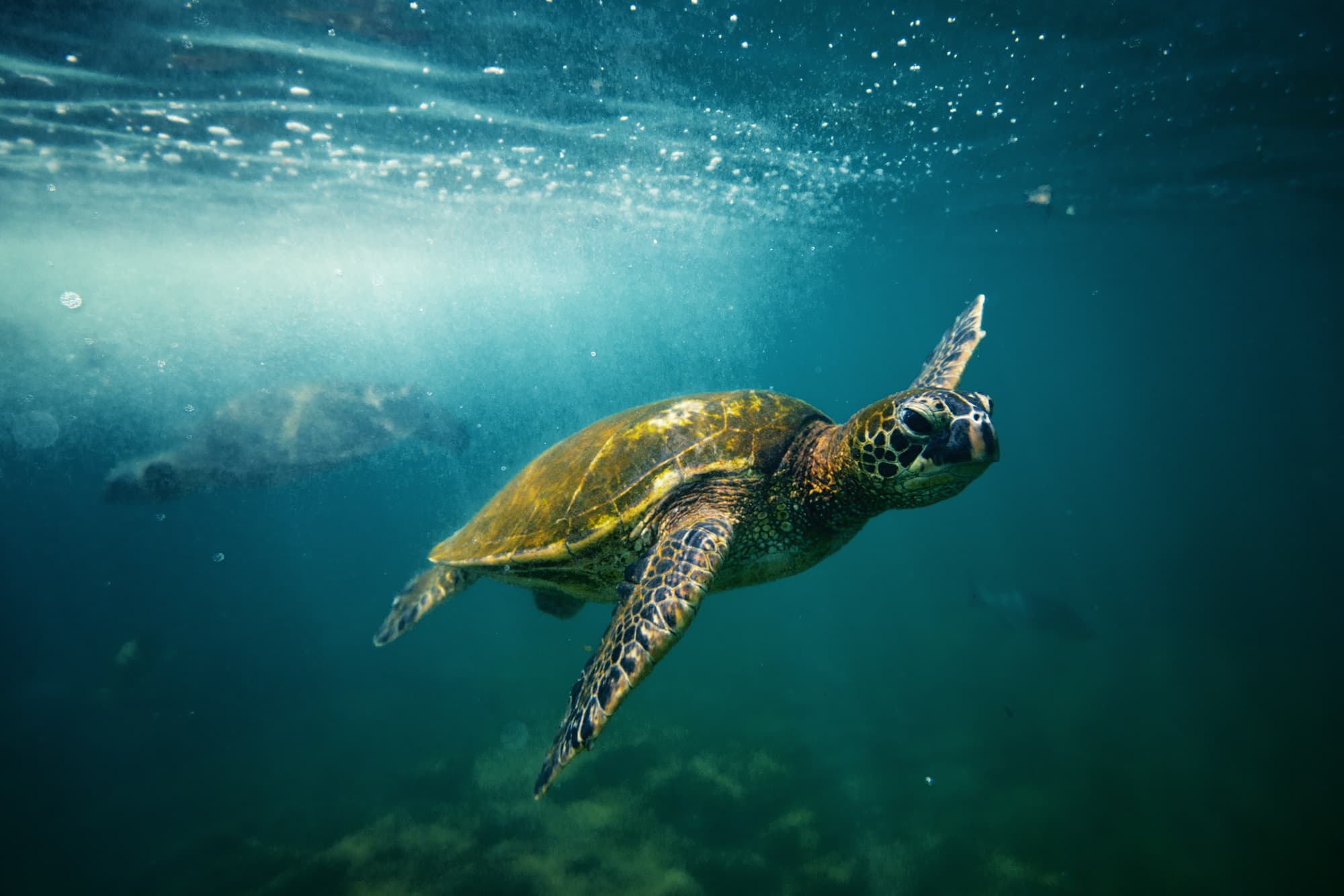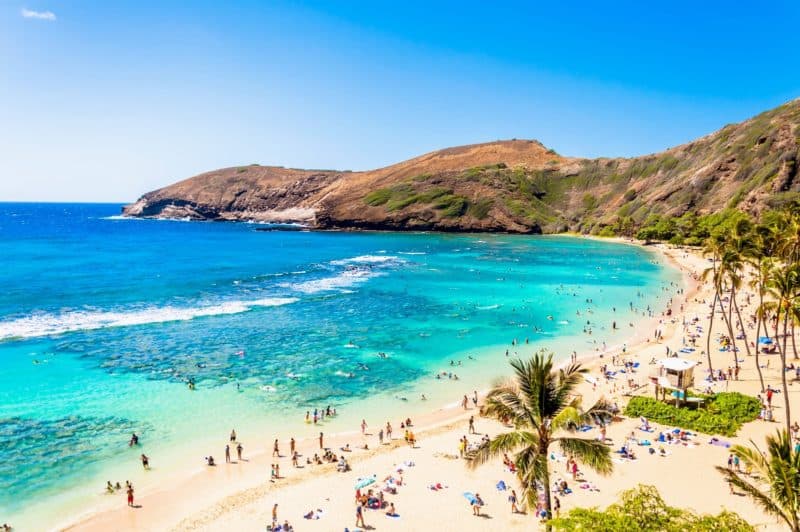One of the most common questions we get from visitors to Hawaiʻi is where they can reliably encounter sea turtles, either on land or in the water.
We love receiving this inquiry, because we know that visitors who appreciate sea turtles are really going to appreciate our islands.
Though no sighting is ever guaranteed (natural areas are not zoos!), there are places around the islands that turtles prefer, places they tend to frequent again and again.
Below, we’ve put together some locations we suggest on each island, as well as some tips and tidbits to make your interaction as rich as possible.
Table of contents
- An introduction to sea turtles in Hawaii
- Best places to see turtles on the Big Island
- Best places to see turtles on Maui
- Best places to see turtles on Kauai
- Best places to see turtles on Oahu
- How to behave around turtles (official rules on approaching)
- Turtle watching tips
Table of Contents
- An introduction to sea turtles in Hawaii
- Best places to see turtles on the Big Island
- Best places to see turtles on Maui
- Best places to see turtles on Kauai
- Best places to see turtles on Oahu
- How to behave around turtles (official rules on approaching)
- Turtle watching tips
Money-saving and trip-enhancing trip planning tips
With life getting so expensive it makes sense to save as much money on your trip as you can. These resources help you to save money (#1), to book the best tours and activities (#2), and greatly simplify trip planning (#3 + #4):
- The Discount Hawaii Car Rentals website is our first stop for a quote when we need a rental car. We like them (a) because they offer the BEST rates, (b) require no prepayment and charge no cancellation fees, and (c) because they offer additional benefits such as free extra drivers and reduced young driver rates.
- We put a LOT of effort in figuring out which tours actually are the best. Have a look at our curated tour section to see tours that get consitently good reviews *and* offer great value.
- Did you know we are giving away free itineraries for all Hawaiian islands? These are a great place to start planing your own trip.
- Our Trip Planning 101 Guide is a another GREAT place to start planning for 1st time visitors.
About Hawaiian Sea Turtles
There are 7 species of sea turtles worldwide, and 5 of those can be found in the waters surrounding Hawaiʻi. However, it it overwhelmingly likely that the turtle you will spot on the beach is the green sea turtle (Honu), which far outnumbers any of the other types.
If you are lucky you could spot a Hawksbill turtle (Honu’ea) in the water, but to get an idea of the population difference, consider the story of this diver, who has seen thousands of Honu but only six Honuʻea.
The other 3 species, the leatherback sea turtle, the loggerhead sea turtle, and the olive ridley sea turtle, are typically found in deeper, offshore waters and are rarely seen by the average visitor.
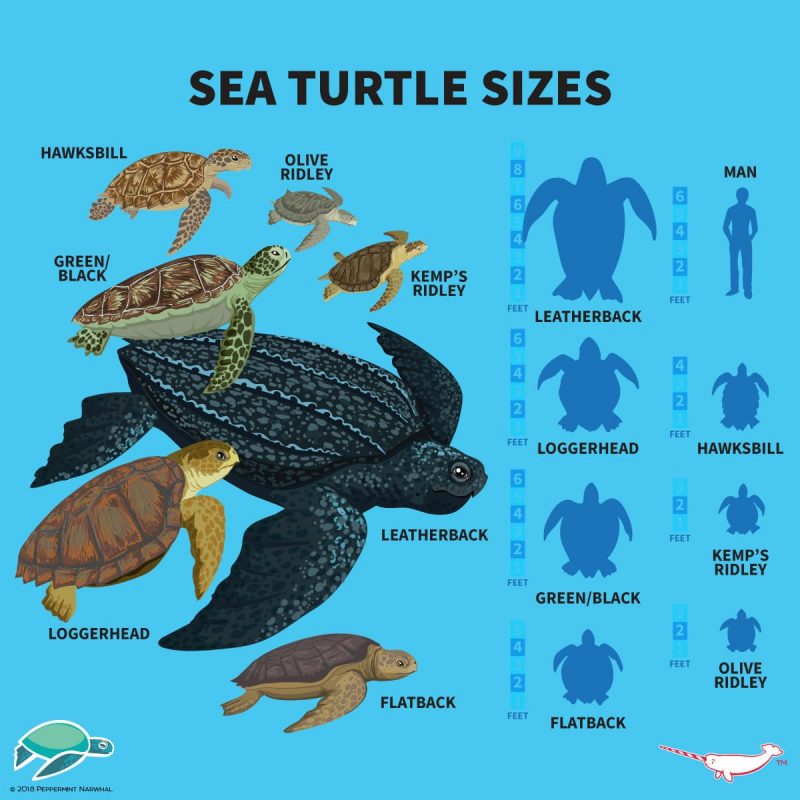
Sea turtle size comparison chart by Peppermint Narwhal.
The Hawaiian green sea turtle
Honu, proudly declared as the “Hawaiian green sea turtle,” can be seen swimming in the shallow waters, resting upon a sandy beach, or nibbling on algae in shallow waters. On average the shell length of an adult Honu is 4 to 5 feet, and they weigh between 200 and 250 pounds. They became a threatened species in 1978, and are protected today under the Endangered Species Act. Their lifespan usually falls between 60 and 80 years.
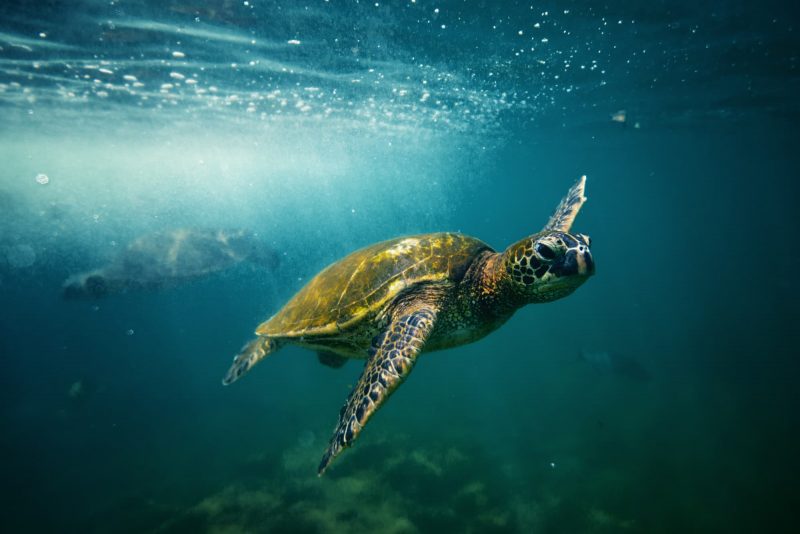
A Hawaiian green sea turtle (Honu) swimming off the coast. Credit: Island of Hawaii Visitors Bureau (IHVB) / Tyler Schmitt
For Hawaiians, the Honu is “a symbol of longevity, safety, and mana (spiritual energy) in Hawaiian culture,” and their presence, in Native Hawaiian mythology, is thought to “represent the eternal link between man, land and sea.”
Fun fact: green sea turtles don’t actually look all that green. They get their name from the color of their internal fat tissue, which is green due to a diet that primarily consists of algae.
Best places to see sea turtles on the Big Island
From Hilo to Kona, there are many turtle hangouts on the Big Island.
Punaluʻu Black Sand Beach
Why go: Does it get any better than sea turtles hanging out on a black sand beach? This is one of the most reliable spots anywhere in the islands, with turtles seen here almost daily, and the ability to park right next to the beach. They rest on the shore, and can often be seen swimming in the surf as well.
Tip: Plan to spend a half day at Punaluʻu. There’s a lifeguard on duty for swimming, and the black sand is unique and beautiful. Go in the early morning or late afternoon; midday, the black sand can make things feel hot.
Want to visit? Read more on our website about visiting Punaluʻu beach.
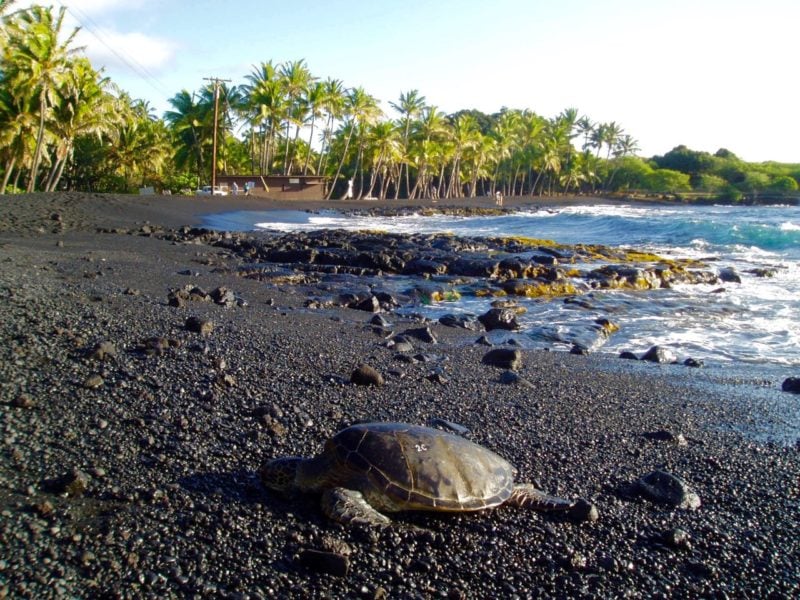
A green sea turtle (a Honu) basking in the sun on Punaluʻu Beach | Photo credits: Steve Cadman on Flickr under a CC BY-SA 2.0 license.
Kahaluʻu Beach Park
Why go: A beautiful snorkeling spot along the Kona coast, Kahaluʻu often gets visits from turtles, who like to hang in its shallow waters. This beach park also is a good family friendly snorkeling area.
Tip: Bring your own gear or rent some from Kahaluʻu Surf and Sea across the street.
Wanna go? Check out our guide for visiting Kahaluʻu Beach.
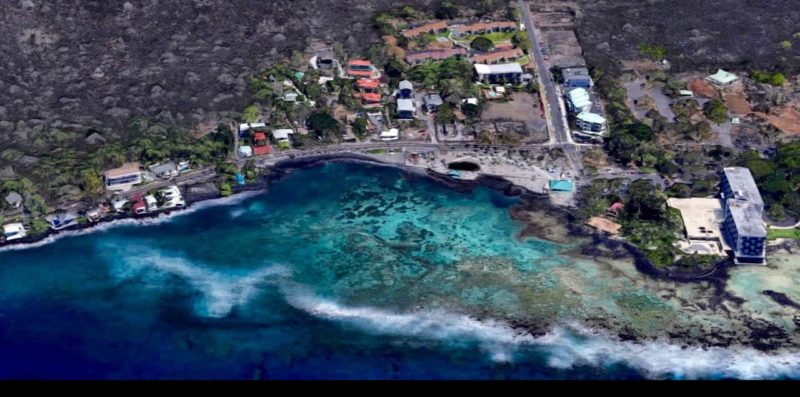
Kahalu’u beach park is one of the best places to go snorkeling on the Big Island. Close to Kona just off Ali’i drive. Image credit: google maps
Best places to see sea turtles on Maui
Driving around Maui? Here are a few spots where you might catch some turtles:
Maluaka Beach
Why go: Known as “Turtle Town,” this south shore beach used to be a hidden gem, and may still be in some ways. Blessed with a sandy bottom and normally calm conditions, it’s a good snorkeling/turtle spotting area for the family.
Tip: Go in the morning when its most calm (turtles like calm water). While you search for turtles, check out some of the other sea life found here, including octopus, eels, triggerfish, angelfish, and more.
Go there on an outrigger canoe tour: if you want to make your turtle experience more special you can take the following outrigger canoe tour that departs from Wailea and visits turtle town. During the trip you get to learn the culture, art and sport of canoe paddling. Your guide will also tell you about the Polynesian Voyagers as they sailed the Polynesian Triangle (New Zealand to Rapa Nui to Hawaii) using Celestial navigation/wayfinding.
Hawaiian Outrigger Canoe Cultural and Turtle Tour
Enjoy the pristine waters off Wailea point and abundant sea life (including turtles!) while you experience a traditional Hawaiian Outrigger Canoe Tour and learn the culture, art, and sport of canoe paddling.
from:
$89
What is a suggested tour?Our suggested tours are hand-picked tours that receive consistent good reviews, give back to the community, and work hard to minimize their impact on the environment. Read more about these tours on our website.How to visit: Maluaka beach is one of our 10 favorite snorkeling spots on Maui.
Hoʻokipa Beach
Why go: Hoʻokipa is along Maui’s north shore; most people pass it along the Road to Hāna. It’s part of a beautiful coastline, and known for its many visiting turtles, who come ashore to rest.
Tip: Hoʻokipa is also a famous surfers beach, and it can be rough, so don’t expect to swim. You can sunbathe, but the beach is rather small. Stop at the overlook for a tremendous view, and if you see turtles on the beach below, you can hike down for a closer look.
Visitor guide: Read more about Hoʻokipa Beach in our guide to Maui Beaches.
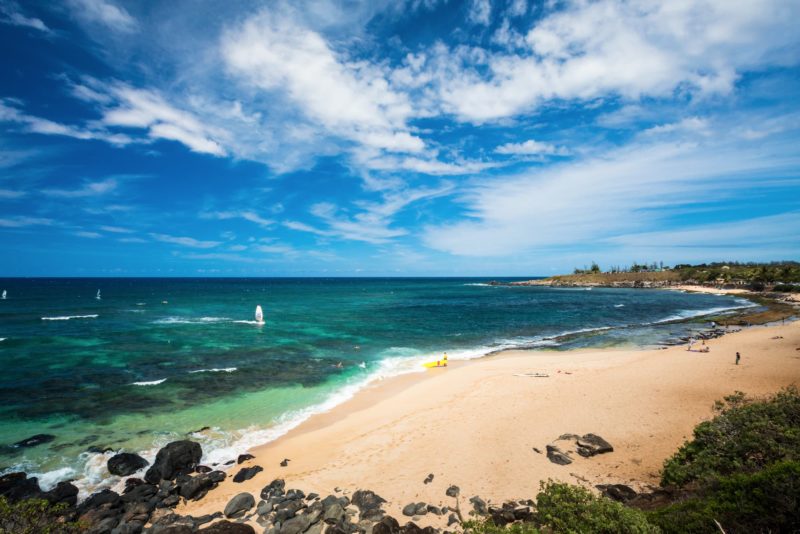
Located at Mile #9 on Hana Highway, Hoʻokipa is a beautiful white sand beach that boasts some of the best waves on the Maui coastline. Credit: Hawaii Tourism Authority (HTA) / Tor Johnson
Best places to see sea turtles on Kauaʻi
Those making camp on the south shore of Kauaʻi will find the area is also popular with sea turtles.
Brennecke’s Beach
Why go: This area in Poʻipū is crowded, so finding a turtle on the beach is rare. You are likely, however, to see them swimming off shore, feeding on the plant life that grows on the reef and rocks.
Tip: Keep your eye on the bodyboarders in the water. Turtles will often swim through their area. If you see a rider pointing at something, it’s most likely a turtle.
Read more about Brennecke’s in our list of Kauaʻi beaches.
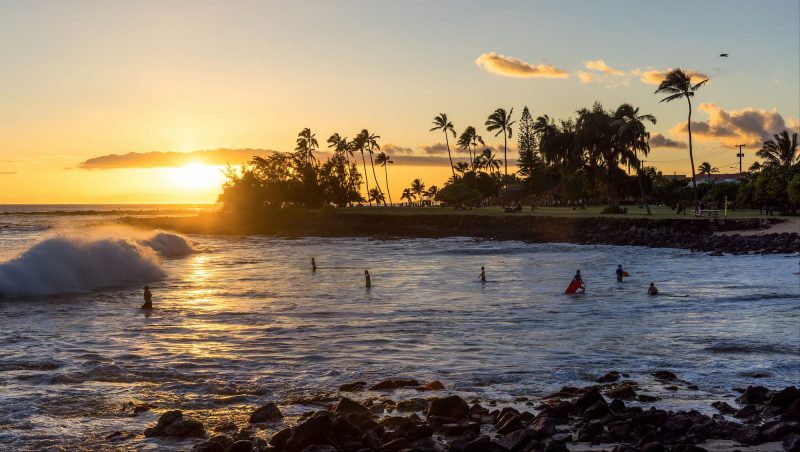
Sunset at Brennecke’s beach. Image credit: Suzanne Neubauer, source.
Lawaʻi Beach
Why go: Also on the south shore near Poʻipū, Lawaʻi Beach is known as a great snorkeling spot. Not only can you see lots of tropical fish, but the Honu also make regular appearances as well. Remember, the more time you spend in the water, the higher your chance of seeing one! So, have fun out there.
Tip: Swim out in front of the Beach House restaurant. Check near the rocks, where turtles like to feed on algae and other sea grass.
Read more about going to Lawaʻi in our list of favorite Kauaʻi snorkeling spots.
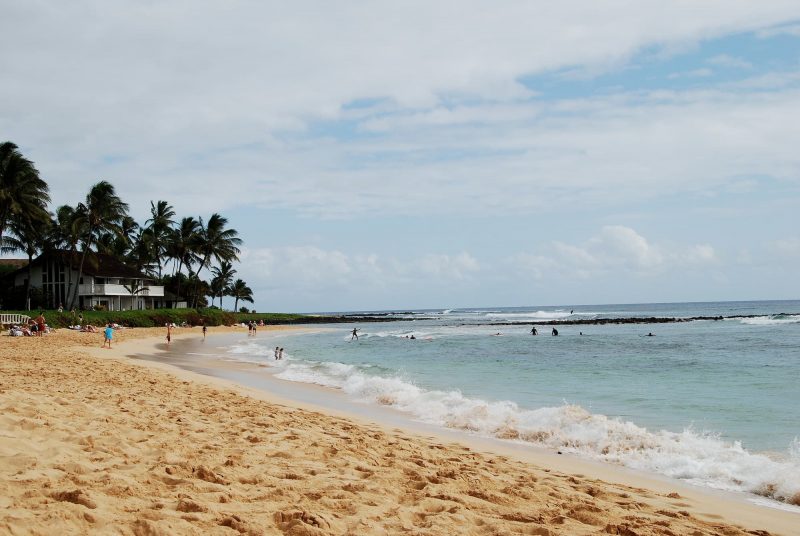
Lawaʻi Beach is a small strip of beach fronting the Lawai Beach resort and the Beach House Restaurant. Image credit: Ben Christen, source.
Best places to see sea turtles on Oʻahu
Oʻahu is the busiest of the islands, but there’s still plenty of room for the Honu.
Laniakea Beach
Why go: This is the go-to turtle beach on Oʻahu, hands down. It’s small, and not really conducive to hanging out, but it sees daily visitation from turtles, with volunteers often posted up to help everyone view respectfully. If you go here two days in a row and don’t see a turtle, you should play the lottery next.
Tip: This beach gets very, very busy, with many people parking along the road and crossing the street to the beach. It creates a lot of traffic on the North Shore, and often some headaches as well. Be respectful when visiting this area and do your part to keep everything organized and safe.
There is more! Don’t confuse Turtle Bay with Laniakea Beach. Turtle Bay is a resort on the north shore of Oʻahu.
How to visit: Check out this list of Oʻahu beaches for more information on visiting Laniakea Beach.
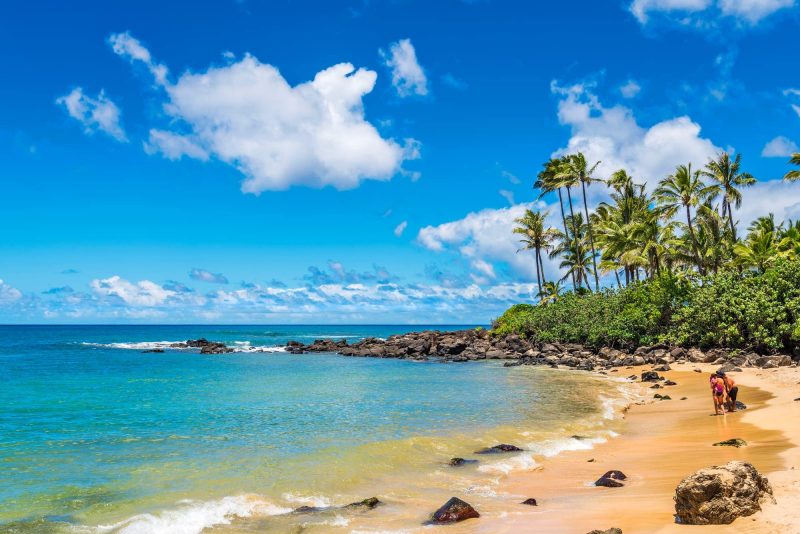
Laniakea Beach is also known as Turtle Beach because of the frequent turtle sightings. Photo by PBphotos
Hanauma Bay
Why go: As a protected bay, life thrives inside of Hanauma Bay. It’s one of the best snorkeling spots on Oʻahu, especially for families, thanks to its safe, calm conditions and abundance of sea life.
Tip: Hanauma Bay is one of the largest natural attractions in the entire state, and it gets crowded during the day. We highly recommend going as early as you can – it opens at 6:45 a.m., but the bulk of the crowds don’t get there until mid-morning. Swim into deeper water to seek out the Honu.
Good to know: Reservations are now required to visit Hanauma Bay and they are difficult to get! Check out our Hanauma Bay guide to see ho to best get them.
Turtle Canyon
Why go: Turtle Canyon is one of the most dependable places to see sea turtles on the south shore. It has many small dense coral formations and serves as a “cleaning station” for turtles, who come to have their shells cleaned by small fish.
Good to know: This area is located offshore of Waikīkī and is best visited via a catamaran or sailing tour. The trip to the snorkeling spot is pretty standard and always offers great views. The biggest difference between providers is the boat (and group) size, which in turn influences the price. See for example the following 2 tours that use vessels with a 40 and 6 people max capacity:
Turtle Canyon Snorkel Excursion (large group, super affordable)
Enjoy a large group (super affordable!) snorkeling trip along the Waikiki Coast to the Turtle Canyons snorkel site.
from:
$75
What is a suggested tour?Our suggested tours are hand-picked tours that receive consistent good reviews, give back to the community, and work hard to minimize their impact on the environment. Read more about these tours on our website.Turtle Canyon Snorkel (Small-Group Tour with 100% Turtle Guarantee)
If you're adventurous and like escaping the crowds - this is for you! Small (6 ppl max) group tours with Turtle Guarantee or Ride again Free.
from:
$109
What is a suggested tour?Our suggested tours are hand-picked tours that receive consistent good reviews, give back to the community, and work hard to minimize their impact on the environment. Read more about these tours on our website.How to behave around turtles
The Honu are protected by federal and state law in Hawaiʻi, including the aforementioned Endangered Species Act. To ensure their safety, please take the following rules to heart:
In the water
It’s very possible that you encounter a turtle while snorkeling in Hawaiʻi. This is a wonderful occurrence! You will enjoy watching it swim through its natural environment. Just remember:
- Never approach a turtle or block its direction of movement.
- Stay back at least 10 feet (3 meters). If the turtle comes toward you, give it space and move out of its way.
- Touching a turtle is not allowed under any circumstances. Do not touch or grab its shell, as it removes beneficial bacteria.
- Do not harass the turtle. If you choose to swim along with the turtle, remain 10 feet away at all times and observe from a distance.
- Do not feed or tempt the turtle in any way.
On land
Please adhere to the following guidelines when interacting with or observing a turtle on land:
- Never try to touch a turtle.
- Do not feed the turtles.
- NOAA and DLNR recommend that everyone stay at least 10 feet (3 meters) from all sea turtles.
- If maintaining 10 feet distance isn’t possible, keep safety in mind and move away from the animal as carefully as possible.
- And, most importantly, enjoy seeing these beautiful creatures!
Please take these regulations seriously. Breaking any of the above can result in a fine or, worse, a negative confrontation with locals.
Turtle watching tips
Here are some final tips for hanging out with sea turtles:
- Turtles eat and rest on and off throughout the day. They can be seen at any time, although they prefer calm water.
- Please use reef-safe sunscreen when snorkeling,
- Wear the right gear. Turtles are often found near rocks, so wear flippers to protect your feet and a rash guard to prevent sunburn.
- Turtles are very photogenic, and majestic to record as they swim. Use a wrist strap to prevent dropping/losing your camera.
